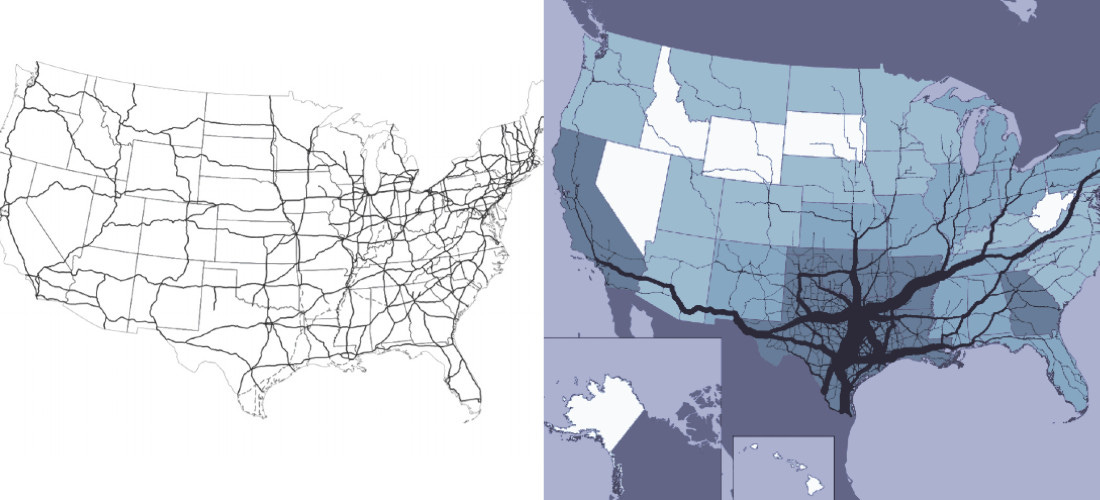“A city is more than a place in space, it is a drama in time.” - Patrick Geddes
In 2014 pharmaceutical giant Roche published an interactive map of metabolic pathways. First compiled in 1965 by Dr. Gerhard Michal, it provides a graphical overview of the most important biochemical pathways in one place. At its essence this is a map of processes - conveying metabolic connections at various scales. This elucidates an impending urban challenge: can we create a similar map of the interdependence of urban systems?
One could envision using such an urban systems map in a mix of top-down expert knowledge and bottom-up conditional planning. The following image is a comparison of the US Interstate Highway on the left, and Texas truck flows in 2010 on the right. We have complete knowledge of the interstate network (top-down), while it’s expression depends on how the commercial fleet makes use of it (bottom-up.)
In this sense urban planning cannot be interpreted as a finite process. Plans should not have an expiry date - they should be circular, continuous and responsive. Here’s a good analogy: DNA is not a top-down blueprint of the human body, but rather a multitude of bottom-up instructions and switches that express themselves when exposed to local signals and conditions.
Blueprint-type processes are a very special kind
— Joe Norman (@normonics) August 17, 2020
Most order and organization in the world does not come from blueprints, but from self-organization and emergence
DNA is not a blueprint, it is a set of switches that determine what a cell does locally, with local signals#RWRI https://t.co/FL3n5xOohC
A controlled but conditional expression of urban features can enable constant planning flexibility based on changing circumstances. Such an approach would transform an urban plan from a static document to a tended set of conditional rules which would express themselves based on a series of local factors.
One Book
SPQR: A history of ancient Rome by Mary Beard\ A fantastic book which recounts the history of Rome from it’s mythical beginnings to the end of the second century of the common era. It’s as objective as possible an account of one thousand years of reign, political intrigue, war and culture. I believe it to be an example of how historians need to write history.
Three Links
Catastrophes and calms by Renée A Duckworth\ On punctuated equilibrium and how we are primed by evolution to be resilient.
The Wuhan I Know by Laura Gao\ An important photo essay on Wuhan by a young graphic artist.
How the Bitcoin Protocol actually works by Michael Nielsen\ An self-explanatory scientific and yet fantastically clear piece of writing.
Five Tweets
The only reason why tenure exists is as a protection of academic freedom. We should start giving it as a reward for actually (& effectively) exercising that freedom, not as a job perk dictated by market conditions, or (even worse) as a reward for conformity.
— Zachary Lipton (@zacharylipton) September 6, 2020
Imagine going back in time one year and showing people this picture of a stadium full of cardboard fans and a sky of orange. pic.twitter.com/8SU5qhfAxf
— Mike Elgan (@MikeElgan) September 11, 2020
People keep telling me humans can't plan for the long-term, on the scale of decades of centuries. But here are 45 examples of 'cathedral thinking' from the past 5000 years, featured in The Good Ancestor 1/2 pic.twitter.com/UNhvL4tYp6
— Roman Krznaric (@romankrznaric) August 31, 2020
Just recorded all my lectures for Quantitative Social Science Methods, I -- the first course in the Harvard Government Dept graduate methods sequence -- and am making them available publicly here: https://t.co/oQfRetbRZr I hope you find them useful for your course, or yourself
— Gary King (@kinggary) August 17, 2020
In Today's Episode of "Go Home Traffic Engineer, You're Drunk": drunk traffic engineer designs huge interchange but forgets to put it in 3D. Is pleased with himself nonetheless. (pic: @vincent313, h/t @FietsRia) pic.twitter.com/g75On3uIZ1
— Lennart Nout (@lennartnout) September 22, 2020
This was the first issue of Think Think Think - a periodic newsletter by Joni Baboci on cities, science and complexity. If you liked it why not subscribe?


